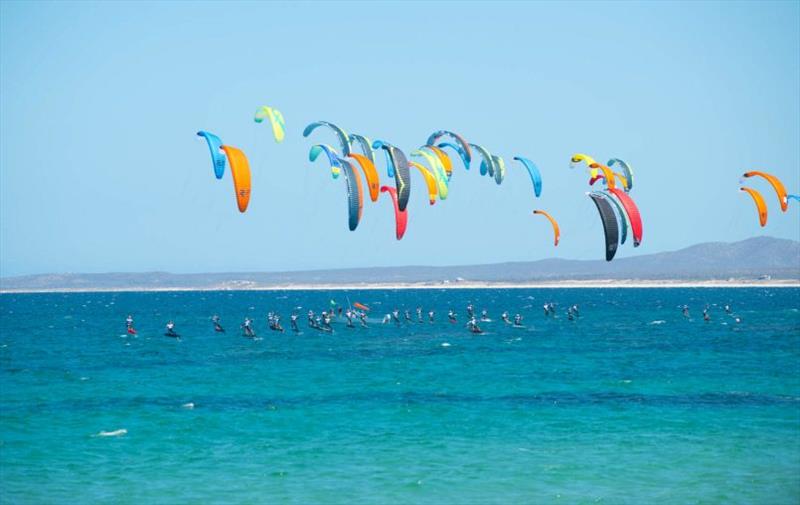
#Kite4Gold does Mexico: The inside story
by Will Carson 27 Apr 2019 12:51 BST

Action from the Hydrofoil Pro Tour at La Ventana, Mexico © Todd Falcke
In September 2018 the British Sailing Team joined forces with the British Kitesports Association and the English Institute of Sport to launch a pioneering talent search for female athletes capable of winning gold in the new Olympic discipline of kite foiling. With a week to go until the start of the 2019 Formula Kite world championships in Lake Garda, Italy, British Sailing Team rider Hannah Peters gives the inside scoop on the #kite4gold programme.
The #kite4gold program started in September 2018 with a lengthy selection process, selecting seven senior athletes to be trained in the adrenaline-filled sport of hydrofoil kiteboard racing. I was lucky enough to be among the seven and have recently returned from ten weeks of training in the foiling paradise of La Ventana, Mexico. There is a big range of backgrounds among the squad: for me kiteboarding came very late and certainly only became serious in October last year when the possibility of running an Olympic campaign became a reality, but there was a mammoth learning curve ahead.
Three months on from the start of the #kite4gold program, I'm in a dust-coated home-build I found cheap on Airbnb. I'm curled up with stomach cramps, waving off mosquitoes, recovering from food poisoning after gorging on dodgy tacos from a semi-derelict shack disguised as a cafe. It's day seven at one of the world's best kite foiling venues, which I will be calling home for the next nine weeks. Thankfully this was the only low moment of my ten weeks in Mexico, which was packed with lengthy days learning the art of kite foiling, challenging conditions and a lovely warm climate.
Located on the remote southern tip of the Baja peninsular, the cold Sea of Cortez creates an aggressive thermal breeze which arrives perfectly on time each morning and increases to the mid-afternoon. Each day, as the clear wind line approached the beach, a scurry of activity usually led by the keen British contingent would assemble in a race to be first on the water and get a paradise hour before the bay becomes packed with fellow kite-boarders.
The learning curve over the first few weeks was phenomenal. Starting on beginner foils and regular inflatable tube kites our squad progressed much sooner than we had all imagined to using full race equipment. We soon become confident using the somewhat daunting foil kites. Having no internal inflation in these kites this led to long swims back to the beach after failed re-launch attempts with the kite slowly sinking in the water.
Team rescue efforts with kayaks and paddleboards were a regular occurrence it became a fun challenge to see who could perform the best or worst deep-water pack-down, christened 'rate my wrap'. The 'swim of shame' gradually became a rarer occurrence, but was inevitable when trying to push boundaries daily in the fight for quick progression.
Just two weeks into our training in Mexico we entered our first ever foiling regatta, held at our training spot. What a baptism of fire! We certainly were not 'race ready' at this stage. Lining up alongside some of the top male riders in pre-start was thrilling, only to be left standing at the gun when they shot off upwind at great pace. Completing the course and surviving the extreme conditions was an achievement for us. A Mexican 'El Norte' storm brought high winds and big seas during the regatta, conditions we had never experienced before. Bruised and battered but still smiling, this test of nerves brought a new found streak of confidence into our foiling.
A big target during the training period was to become race-ready in time for the Mexican Hydrofoil Pro-Tour regatta in mid-March, the last week of our training camp. This regatta would bring in global professional riders and be a great opportunity to gauge our skills against the world's best.
The venue itself was a paradise and safe haven. As the thermal breeze receded daily into the evenings a foiling 'golden hour' presents itself, the highlight of everyone's day. Flat water, lighter breeze requiring bigger kites and few people on the water. The golden hour was prime time for line-ups and speed runs. Our foiling confidence and skills improved at rocket pace, being able to have two or three water sessions each day. Confidence does come at a price enjoying ourselves a little too much into the evening and wanting that 'one more tack' before heading in, we often got court out by the dropping breeze and once again enjoyed a slow swim home with a soggy kite which simply won't fly in zero wind!
The team have established valuable relationships with fellow kite-foilers and locals who have become good friends and helped tremendously throughout our winding path of progression. The support on and off the water has been wonderful.
Eventually the Baja dream had to end. We just about managed to squeezed our mammoth amount of kit into numerous overweight bags and headed back to the UK for some cold-water training at Weymouth and Portland National Sailing Academy with one month until the world championships.